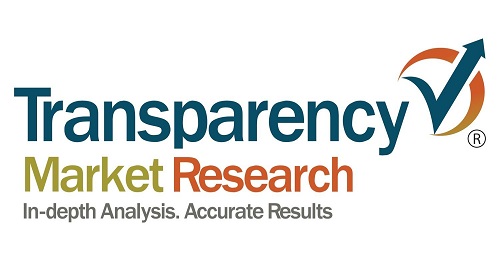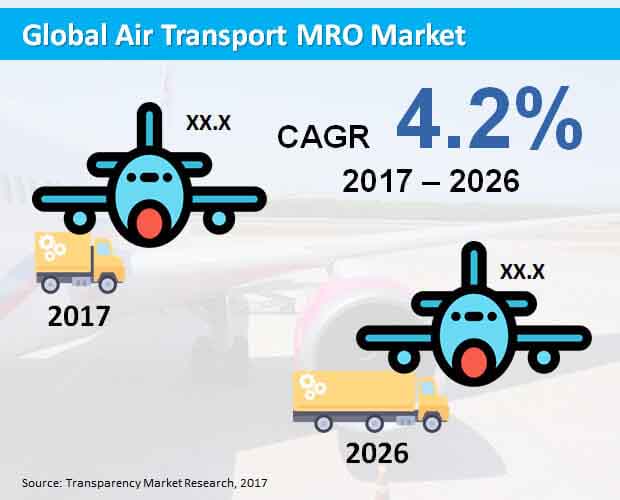
Maintenance, Repair, and Operation (MRO) plays an important role in the airline industry. MRO has become one of the major expenditure by the airline company as international aviation authorities across the globe has made MRO mandatory. One of the biggest driving factors in the air transport MRO market is increasing focus on cost reduction through proper maintenance. However, OEMs are also focusing on aftermarket services which is proving to be successful, thus hampering independent MRO companies, especially small businesses.
Get Sample Copy:
https://www.transparencymarketresearch.com/sample/sample.php?flag=S&rep_id=36641
According to a study by Transparency Market Research (TMR), the global air transport MRO market is expected to witness moderate growth. The market is estimated to register 4.2% CAGR between 2017 and 2026. The global market for air transport MRO is also likely to reach US$ 101,941.2 million revenue by the end of 2026.
Engine to Witness Steady Growth during 2017-2026
An engine is expected to account for nearly half of the revenue share by 2017 end. Engine is projected to reach close to US$ 42,800 million revenue towards the end of 2026. Engine being an important part of the aircraft, maintenance, periodic checking, and repairing of engine is done on the large scale. Hence, engine is responsible for majority of MRO market’s value. Moreover, there has been an increase in the number of joint ventures between OEM and MRO along with the focus on the next-generation engine. Also as the aircraft gets older, more value is transferred to its engine, hence more focus is given to the maintenance and repair of aircraft engine.
Grab an exclusive PDF Brochure of this report:
https://www.transparencymarketresearch.com/sample/sample.php?flag=B&rep_id=36641
Narrowbody Aircraft to Gain Maximum Traction in the Global Air Transport MRO Market
Compared to various types of aircrafts, narrowbody aircraft is likely to gain maximum traction. By the end of 2026, the narrowbody aircraft is estimated to surpass US$ 51,900 million revenue. Narrowbody aircrafts are replacing existing aircrafts, hence, maintenance industry is providing support to new single-aisle jets by appointing qualified workforce to handle the maintenance service and provide necessary support. However, high cost of repair, retrofit of old aircraft with the upgraded system are some of the factors restricting the growth of narrowbody aircraft MRO. The trend of outsourcing line maintenance to the third party MRO service providers is also emerging.

OEM to Emerge as the Largest Air Transport MRO Provider during 2017-2026
Original Equipment Manufacturer (OEM) is likely to emerge as one of the largest MRO providers. Between 2017 and 2026, OEM is estimated to create an incremental opportunity of more than US$ 19,500 million. Owing to the development of new generation of commercial jets, component, airframe, engine, OEMs are witnessing better revenue generating opportunities in the aftermarket services. With the launch of next-gen aircrafts, MRO companies are entering into a partnership with OEMs to maintain their position in providing maintenance, repair and overhaul services.
Europe to Remain Dominant in the Global Market for Air Transport MRO
Europe is likely to account for the highest share in the global air transport MRO market between 2017 and 2026. There has been an increase in the airlines replacing old aircrafts with new technology models in Europe. This has resulted in the growth of MRO market, especially for single-aisle jets in Eastern and Western Europe. Meanwhile, the air transport MRO market is also focusing on developing automated mechanism to gain sustainable economic advantages to Aviation Company as well as third parties. However, lack of skilled workforce is one of the biggest challenges in the air transport MRO market across the globe.
Request For Customization:
https://www.transparencymarketresearch.com/sample/sample.php?flag=CR&rep_id=36641
Competition Tracking
Some of the prominent players in the global market for air transport MRO market are MTU Aero Engines AG, Deutsche Lufthansa Aktiengesellschaft, Iberia Lineas Aereas de Espana S.A., John Swire & Sons HK Ltd, General Electric Company, Delta Air Lines, Inc., British Airways PLC, Air France-KLM SA, China National Aviation Holding Company, and AAR Corporation.
Air Transport Maintenance, Repair, and Overhaul (MRO) Market Pins High Hopes on Blockchain to Gain Substantial Cost Reduction
Air transport maintenance, repair, and overhaul (MRO) market has evolved on the back of the evolving regulatory and compliance frameworks in various countries. Growing focus on maintaining the airworthiness of commercial aircrafts is a key trend driving the demand for new systems, technologies, and maintenance schedules in the air transport MRO market. Strides being made by aviation industry in various developing regions of the world have focused on reducing the overall cost of MRO operations. A number of services have emerged to meet the demand for civil and military transport operations. The need for reducing the overall cost of air transport MRO operations has propelled the aviation industry to test new and novel technologies. A case in point is blockchain technology. The technology is a novel one and is showing vast potential in tracking aircraft parts. The cost gains may run into billions according to some of the recent research. A number of blockchain alliances launched in MRO has expanded the horizon for players in the air transport MRO market. The movement and maintenance history of commercial aircraft parts is increasingly complex, and the blockchain is emerging as a novel system to meet the needs of the logistic value chain. In many proof of concept studies, the aviation industry has seen the blockchain to facilitate information sharing between the stakeholders.
Rise in demand for cost cutting has also become vital in the wake of Covid-19 putting bans on the commercial flying. Thus, air transport MRO market is also looking to leverage the technologies that can help it to be agile when the pandemic has led to the aviation industry squeezing profits. Further, over the last few months as the airports allow commercial flying, air transport MRO operators must also adopt systems that help maintain pandemic-specific guidelines. This will see some interesting avenues cropping up in the air transport MRO market.





